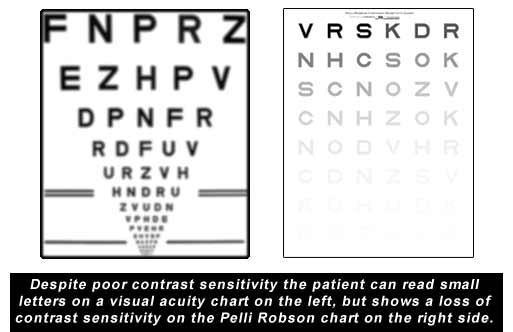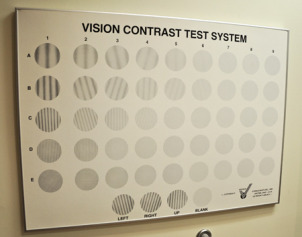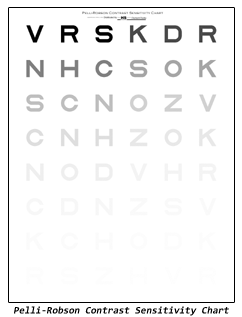Contrast Sensitivity Testing
Contrast sensitivity refers to the ability of the visual system to perceive an object or shape from its background. Imagine a grey pen on a slightly darker grey desk. It would be difficult for a patient with poor contrast to distinguish between the two. However, that same patient might easily see a dark letter on a white visual acuity chart because the contrast is very high. Thus contrast sensitivity testing will detect visual impairment that cannot be measured on a visual acuity chart with high contrast black on white.

Contrast sensitivity is a better measurement of real world functioning than visual acuity. Failure to test contrast sensitivity may leave a patient with only moderate visual acuity loss faced with an unrecognized day-to-day visual problems in the real world.

Contrast sensitivity can be tested in many different ways. Some test charts use letters that gradually reduce in contrast. The patient is tested to determine the limit of reducing contrast letters that can be identified. Other contrast sensitivity charts use gratings that gradually change in the contrast and frequency of dark to light oscillations on the plate. Both types can determine the loss of contrast sensitivity.
Poor contrast sensitivity is common in many visual disorders including cataract, diabetic retinopathy and many retinal disorders. We can aid contrast  sensitivity in these patients with the use of high contrast filters, better lighting and by the use of bolder higher contrast materials. In cataract patients, surgical removal of the cataract may significantly improve contrast sensitivity.
sensitivity in these patients with the use of high contrast filters, better lighting and by the use of bolder higher contrast materials. In cataract patients, surgical removal of the cataract may significantly improve contrast sensitivity.
The Pelli-Robson Contrast Sensitivity Chart has proven to be a quick and reliable test. Studies at Queensland University of Technology showed that scores on the Pelli-Robson test correlated highly with driving performance of patients with simulated visual impairments. These results have been duplicated in patients with real visual impairment.
